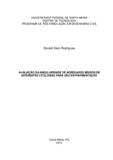| dc.creator | Rodrigues, Danieli Klein | |
| dc.date.accessioned | 2020-03-02T13:31:04Z | |
| dc.date.available | 2020-03-02T13:31:04Z | |
| dc.date.issued | 2019-08-30 | |
| dc.identifier.uri | http://repositorio.ufsm.br/handle/1/19685 | |
| dc.description.abstract | Aggregates are of great importance in the composition of asphalt concrete mixtures (AC) occupying a volume between 80 and 90% of the total volume, where angularity interferes with the performance of asphalt coatings. This research aims to evaluate the shape, angularity and surface texture of fine aggregates (such as stone dust and sand) by implementing the fine aggregate angularity test (FAA) at the Federal University of Santa Maria - RS. The fine aggregates to be used come from various locations in the state of Rio Grande do Sul, samples already studied of fine and coarse aggregates by other researchers, associating their physical characteristics, sphericity, angularity and surface texture and direct shear strength. It began with the implementation of equipment and collection of materials; the evaluation of the angularity of fine aggregates is obtained through the volume of uncompressed voids following ASTM C 1252/06. The test of visual analysis of angularity, sphericity and surface texture by microscope and AIMS (Aggregate Image Measurement System) according to the obtained results will be specified for use according to the traffic volume. The surface texture and angularity of the fine aggregates interfere with the direct shear strength. The polished, smooth texture, sphericity and rounded and elongated roundness / angularity aggregates did not resist the imposed normal stress. Taking into account only results obtained from the FAA test we cannot define which fine aggregates are most suitable, for high traffic volume asphalt mixtures should be analyzed and compared with the visual analysis by microscope. | eng |
| dc.language | por | por |
| dc.publisher | Universidade Federal de Santa Maria | por |
| dc.rights | Attribution-NonCommercial-NoDerivatives 4.0 International | * |
| dc.rights.uri | http://creativecommons.org/licenses/by-nc-nd/4.0/ | * |
| dc.subject | Agregados fino | por |
| dc.subject | Caracterização física | por |
| dc.subject | Angularidade | por |
| dc.subject | Cisalhamento direto | por |
| dc.subject | Correlação linear | por |
| dc.subject | Fine aggregates | eng |
| dc.subject | Physical characterization | eng |
| dc.subject | Angularity | eng |
| dc.subject | Direct shear | eng |
| dc.subject | Linear correlation | eng |
| dc.title | Avaliação da angularidade de agregados miúdos de diferentes litologias para uso em pavimentação | por |
| dc.title.alternative | Evaluation of angularity of kid aggregates of different litologies for paving | eng |
| dc.type | Dissertação | por |
| dc.description.resumo | Os agregados são de grande importância na composição de misturas de concreto asfálticas (CA) ocupando um volume entre 80 e 90% do volume total, onde a angularidade interfere no desempenho dos revestimentos asfálticos. A presente pesquisa busca avaliar a forma, a angularidade e a textura superficial dos agregados finos (como pó-de-pedra e areia) através da implantação do ensaio de angularidade do agregado fino (FAA) na Universidade Federal de Santa Maria – RS. Os agregados finos a serem utilizados são provenientes de diversas localidades do estado do Rio Grande do Sul, amostras já estudadas de agregados finos e graúdos por outros pesquisadores, associando suas características físicas, esfericidade, angularidade e textura superficial e resistência ao cisalhamento direto. Iniciou-se com a implantação do equipamento e coleta dos matérias; a avaliação da angularidade dos agregados finos se obtém através do volume de vazios não compactados seguindo a normativa da ASTM C 1252/06.O ensaio de analise visual da angularidade, esfericidade e textura superficial através de microscópio e AIMS (Aggregate Image Measurement System), de acordo com os resultados obtidos será especificado para utilização de acordo com o volume de tráfego. A textura superficial e a angularidade dos agregados finos interfere na resistência ao cisalhamento direto os agregados de textura polida, lisa, esfericidade e arredondamento/angularidade arredondado e alongados não resistiram a tensão normal imposta. Levando em consideração apenas resultados obtidos do ensaio de FAA não podemos definir quais os agregados finos são mais adequados, para misturas asfálticas para alto volume de tráfego deve-se analisar e comparar com as analise visual através de microscópio. | por |
| dc.contributor.advisor1 | Pinheiro, Rinaldo Jose Barbosa | |
| dc.contributor.advisor1Lattes | http://lattes.cnpq.br/1539316781096410 | por |
| dc.contributor.referee1 | Specht, Luciano Pivoto | |
| dc.contributor.referee1Lattes | http://lattes.cnpq.br/8038412953408618 | por |
| dc.contributor.referee2 | Brito, Lélio Antônio Teixeira | |
| dc.contributor.referee2Lattes | http://lattes.cnpq.br/2156590638853724 | por |
| dc.creator.Lattes | http://lattes.cnpq.br/7882360170757117 | por |
| dc.publisher.country | Brasil | por |
| dc.publisher.department | Engenharia Civil | por |
| dc.publisher.initials | UFSM | por |
| dc.publisher.program | Programa de Pós-Graduação em Engenharia Civil | por |
| dc.subject.cnpq | CNPQ::ENGENHARIAS::ENGENHARIA CIVIL | por |
| dc.publisher.unidade | Centro de Tecnologia | por |



